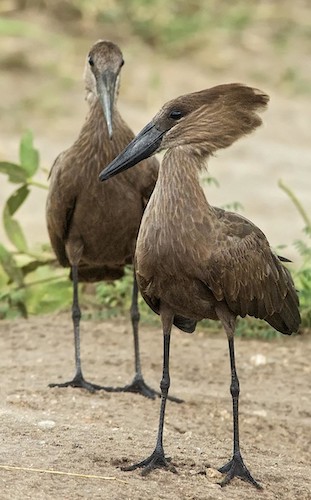Scopidae – Hammerkop

This family has just one species, which is:
Hammerkop Scopus umbretta
There are two subspecies:
Scopus umbretta umbretta
Scopus umbreta minor
The hamerkop Scopus umbretta, also known as hammerkop, hammerkopf, hammerhead, hammerhead stork, umbrette, umber bird, tufted umber, or anvilhead, is a medium-sized wading bird 56 centimetres (22 in) in length with a weight of 470 grams (17 oz). The shape of its head with a long bill and crest at the back is reminiscent of a hammer, hence its name. It ranges from Africa, Madagascar to Arabia, in wetlands of a wide variety, including estuaries, lakesides, fish ponds, riverbanks and rocky coasts in Tanzania. The hamerkop, which is a sedentary bird that often show local movements, is not globally threatened and is locally abundant in Africa and Madagascar.
It is usually included in the Ciconiiformes, but might be closer to the Pelecaniformes. It constitutes a family (Scopidae) and genus (Scopus) all on its own because of its unique characteristics.
Its plumage is a drab brown with purple iridescence on the back (the subspecies S. u. minor is darker). The bill is long, flat, and slightly hooked. The neck and legs are shorter than those of most of the Ciconiiformes. The hamerkop has, for unknown reasons, partially webbed feet. The middle toe is comb-like (pectinated) like a heron’s. Its tail is short and its wings are big, wide, and round-tipped; it soars well. When it does so, it stretches its neck forward like a stork or ibis, but when it flaps, it coils its neck back something like a heron.
Vocalisations include cackles and a shrill call given in flight. Hamerkops are mostly silent except when in groups.
The hamerkop occurs in Africa south of the Sahara, Madagascar and coastal south-west Arabia in all wetland habitats, including irrigated land such as rice paddies, as well as in savannahs and forests. Most are sedentary within their territories, which are held by pairs, but some migrate into suitable habitat during the wet season only. Whenever new bodies of water are created, such as dams or canals, hamerkops quickly move in.
The hamerkop’s behaviour is unlike other birds. One unusual feature is that up to ten birds join in ‘ceremonies’ in which they run circles around each other, all calling loudly, raising their crests, fluttering their wings. Another is ‘false mounting’, in which one bird stands on top of another and appears to mount it, but they may not be mates and do not copulate.
They are compulsive nest builders, constructing three to five nests per year whether they are breeding or not. Barn owls and eagle owls may force them out and take over the nests, but when the owls leave, the hamerkops may reuse the nests. Snakes, small mammals such as genets, and various birds live in abandoned nests, and weaver birds, starlings, and pigeons may attach their nests to the outside.
Hamerkops feed during the day, often taking a break at noon to roost. They normally feed alone or in pairs. The food is typical of long-legged wading birds, and the most important is amphibians. They also eat fish, shrimp, insects and rodents. They walk in shallow water looking for prey, shuffling one foot at a time on the bottom or suddenly opening their wings to flush prey out of hiding. The same shuffling technique is used to locate food in middens of fish remains.
-
Hamerkop Scopus umbretta
Species AccountThe hamerkop (Scopus umbretta), also known as hammerkop, hammerkopf, hammerhead, hammerhead stork, umbrette, umber bird, tufted umber, or anvilhead, is a medium-sized wading bird 56 centimetres (22 in) in length with a weight of 470 grams (17 oz). The shape of its head with a long bill and crest at the back is reminiscent of a hammer, hence its name.… -
Hamerkop Scopus umbretta
Species AccountSound archive and distribution map.
-
Number of bird species: 1
